Shingle Roofers Manchester
Find the best Asphalt Shingle Roofer in Manchester
Receive multiple Asphalt Shingle Roofer quotes for your project today! Compare profiles, reviews, accreditations, portfolio, etc... and choose the best service.

J Mac Roofing & Building
510 reviewsManchester, GBJ Mac Roofing & Building serves as the leading Roofing Contracting firm in the Manchester area. We’re a team of fully-certified professionals who tackle everything from complex large projects to smaller scale jobs. Fuelled by our commitment to excellence, we go the extra mile to make sure our clients are completely satisfied with our work. From slate replacement to large new roof installations, we specialise in all aspects of slated, tiled, flat and fibreglass covered roofs. We only use high-quality materials for all our roofing work so you can be sure that your roof will be strong and durable for years to come. About J Mac Roofing & Building Benefiting from many years of experience, J Mac Roofing & Building is a top provider of roofing services as well as specialist roof repair services in Manchester along with the surrounding area. Our company is recognised as one of Manchester’s main roofing companies, a roofing specialist with an valued reputation for supplying a top notch roofing service. We’ll take on any size job, from a small roof repair through to a full roof replacement which includes pitching up of flat roofs, felt roofs, conservatory roofing, Velux windows and uPVC roof line replacement. All our staff reflect our organisation beliefs and therefore follow our high-standard of customer support, your residence will be taken care of while using the utmost respect always.
- Services
- Why Us?
- Gallery
Get Quote
JM Contractors
4.752 reviewsOffice 242 30 The Downs, Altrincham, WA14 2PX, GBJM Contractors is a family-run business based in Greater Manchester, specializing in property maintenance services. With years of experience in the roofing trade, they pride themselves on providing a hassle-free and affordable service that prioritizes customer needs, quality workmanship, and modern standards. They offer a wide range range of services, including roof installations, repairs, conversions, and upgrades, as well as UPVC fascias, soffits, guttering, and pressure washing. JM Contractors is committed to exceeding customer expectations and building lasting relationships through their punctuality, honesty, reliability, and friendly service.
- Services
- Why Us?
- Gallery
Get Quote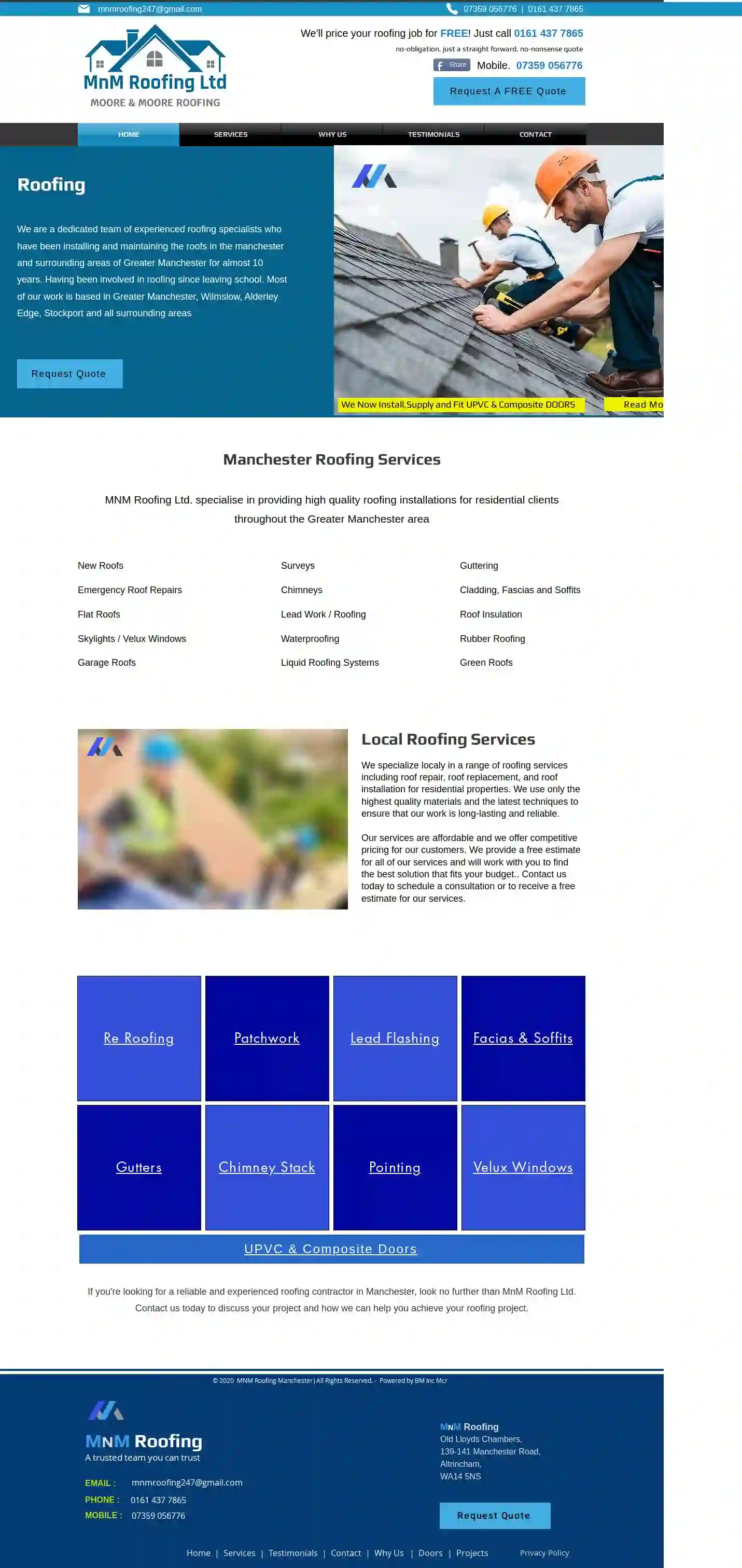
MNM Roofing Ltd
55 reviews139-141 Manchester Road, Old Lloyds Chambers, Altrincham, WA14 5NS, GBMNM Roofing Ltd. is a dedicated team of experienced roofing specialists serving the Manchester and surrounding areas of Greater Manchester for almost 10 years. With a history rooted in roofing since leaving school, the company focuses primarily on Greater Manchester, Wilmslow, Alderley Edge, and Stockport. MNM Roofing Ltd. specializes in providing high-quality roofing installations for residential clients throughout the Greater Manchester area. They offer a comprehensive range of services, including new roofs, emergency roof repairs, flat roofs, skylights/Velux windows, garage roofs, surveys, chimneys, lead work, waterproofing, liquid roofing systems, guttering, cladding, fascias and soffits, roof insulation, rubber roofing, and green roofs. The company prides itself on using only the highest quality materials and the latest techniques to ensure long-lasting and reliable work. They are committed to providing affordable services with competitive pricing and offer free estimates for all their services. MNM Roofing Ltd. is a trusted team you can rely on for all your roofing needs. Contact them today to discuss your project and how they can help you achieve your roofing goals.
- Services
- Why Us?
- Gallery
Get Quote
Crescent Roofing
2.33 reviewsUnit 10, The Mill, 1000 Trafford Park, Manchester, M5 4AA, GBCrescent Roofing, based in Salford, Manchester, is a family-run business established in 1989. They specialize in meeting the roofing needs of every customer, prioritizing safe systems of work, quality workmanship, and superior materials. Whether it's a small repair or a large-scale project, Crescent Roofing prides itself on providing courteous, professional service and a dedication to health and safety. They offer a wide range of roofing solutions, including pitched roofing, flat roofing, and various materials like slates, tiles, lead, built-up felt, single ply, EPDM, GRP, sheeting, and cladding. With over 373 years of combined experience on their team, Crescent Roofing is committed to delivering quality roofs that last. They are proud to be an Investor in People silver awarded organisation, constantly striving to improve their business practices and employee skills.
- Services
- Why Us?
- Accreditations
- Gallery
Get Quote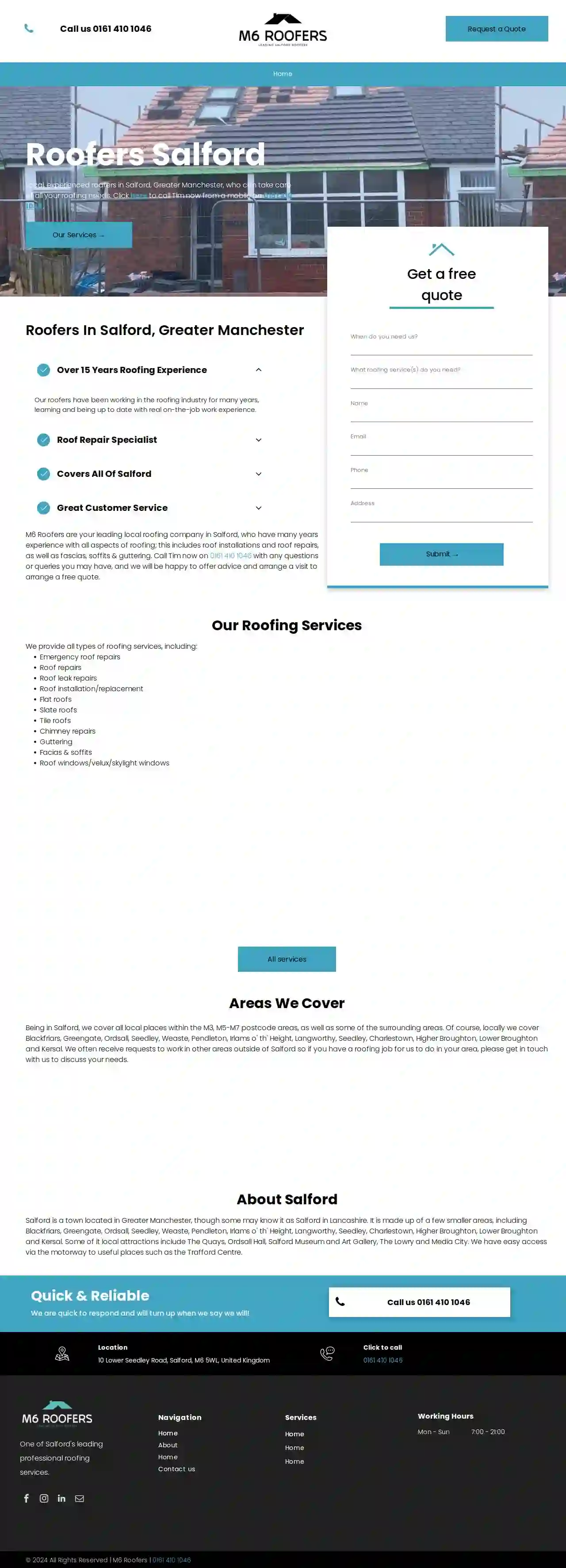
M6 Roofers
55 reviews10 Lower Seedley Road, Salford, M6 5WL, GBM6 Roofers are your leading local roofing company in Salford, who have many years experience with all aspects of roofing; this includes roof installations and roof repairs, as well as fascias, soffits & guttering. We provide all types of roofing services, including emergency roof repairs, roof repairs, roof leak repairs, roof installation/replacement, flat roofs, slate roofs, tile roofs, chimney repairs, guttering, facias & soffits, and roof windows/velux/skylight windows. Our roofers have been working in the roofing industry for many years, learning and being up to date with real on-the-job work experience. We are based in M6 Salford, and work here and all surrounding Salford areas, including Seedley, Irlams o' th' Height, Higher & Lower Broughton, Worsley and Wardley. We provide a high quality yet easy personable experience, and are quick to respond and will turn up when we say we will!
- Services
- Why Us?
- Gallery
Get Quote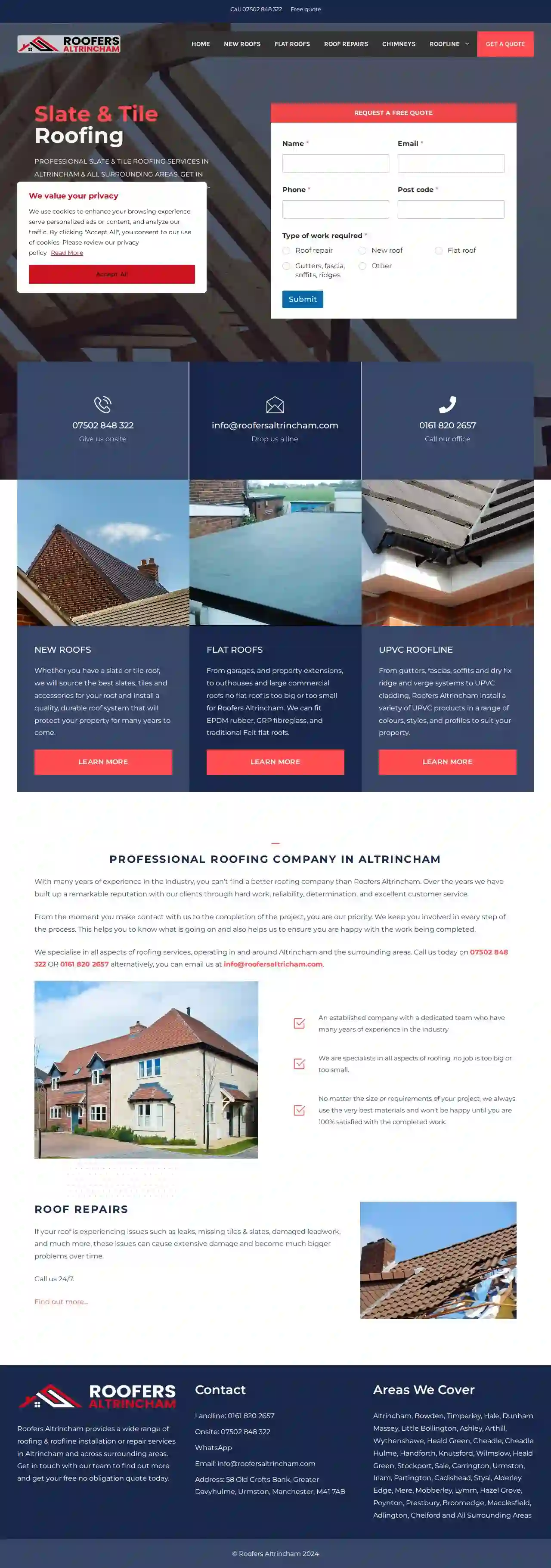
Roofers Altrincham
51 reviews58 Old Crofts Bank, Greater Davyhulme, Urmston, M41 7AB, GBRoofers Altrincham is a family-run roofing company serving Altrincham and the surrounding areas. With many years of experience in the industry, they pride themselves on their hard work, reliability, and excellent customer service. They offer a complete range of roofing services, including new roofs, flat roofs, roof repairs, gutters, fascias, soffits, chimneys, and dry verges & dry ridges. Roofers Altrincham uses the very best materials and ensures customer satisfaction with every project. They are available 24/7 for roof repairs and encourage customers to contact them for a free, no-obligation quote.
- Services
- Why Us?
- Gallery
Get Quote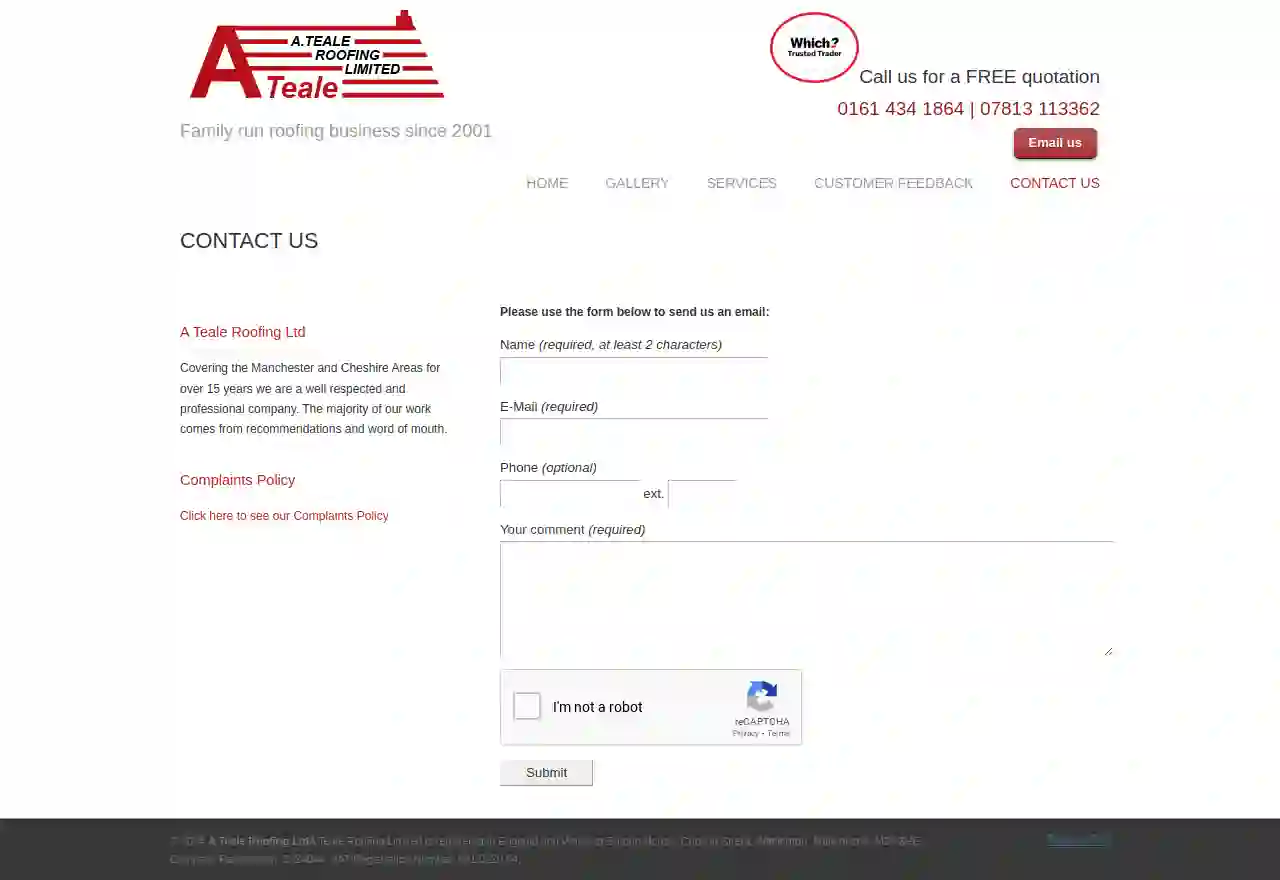
A Teale Roofing Ltd
4.511 reviewsSurcon House, Copson Street, Withington, M20 3HE, GBWelcome to A Teale roofing. A family run business since 2001. We have grown as a family business to become the established and trusted roofing company we are today. A TEALE ROOFING LIMITED Roofing specialists for all types of replacement and repair. Professional A Teale Roofing LImited meet the needs and requirements of you the customer and provide solutions to all of your roofing problems. Do not hesitate to call us today for a free estimate. Reliable Providing roofing services in the Manchester and Cheshire areas for over 20 years we are a well respected and professional company and the majority of our work comes from recommendations and word of mouth. Competitive As an employer we ensure that our team of skilled roofers work to a safe standard, while maintaining a high quality service - the type you would expect from a team that possesses expertise in all areas of the roofing industry. What We Do We cover all types of roofing From full re-roofs to storm damage repairs, we pride ourselves on our old-fashioned approach to customer service which ensures that we respond quickly, at your convenience and that we fully explain everything we do. Whether you are in the early stages of planning, or ready to start a project. Do not hesitate to call us today for a free estimate. We will be happy to answer any questions or queries you may have.
- Services
- Why Us?
- Accreditations
- Our Team
- Testimonials
- Gallery
Get Quote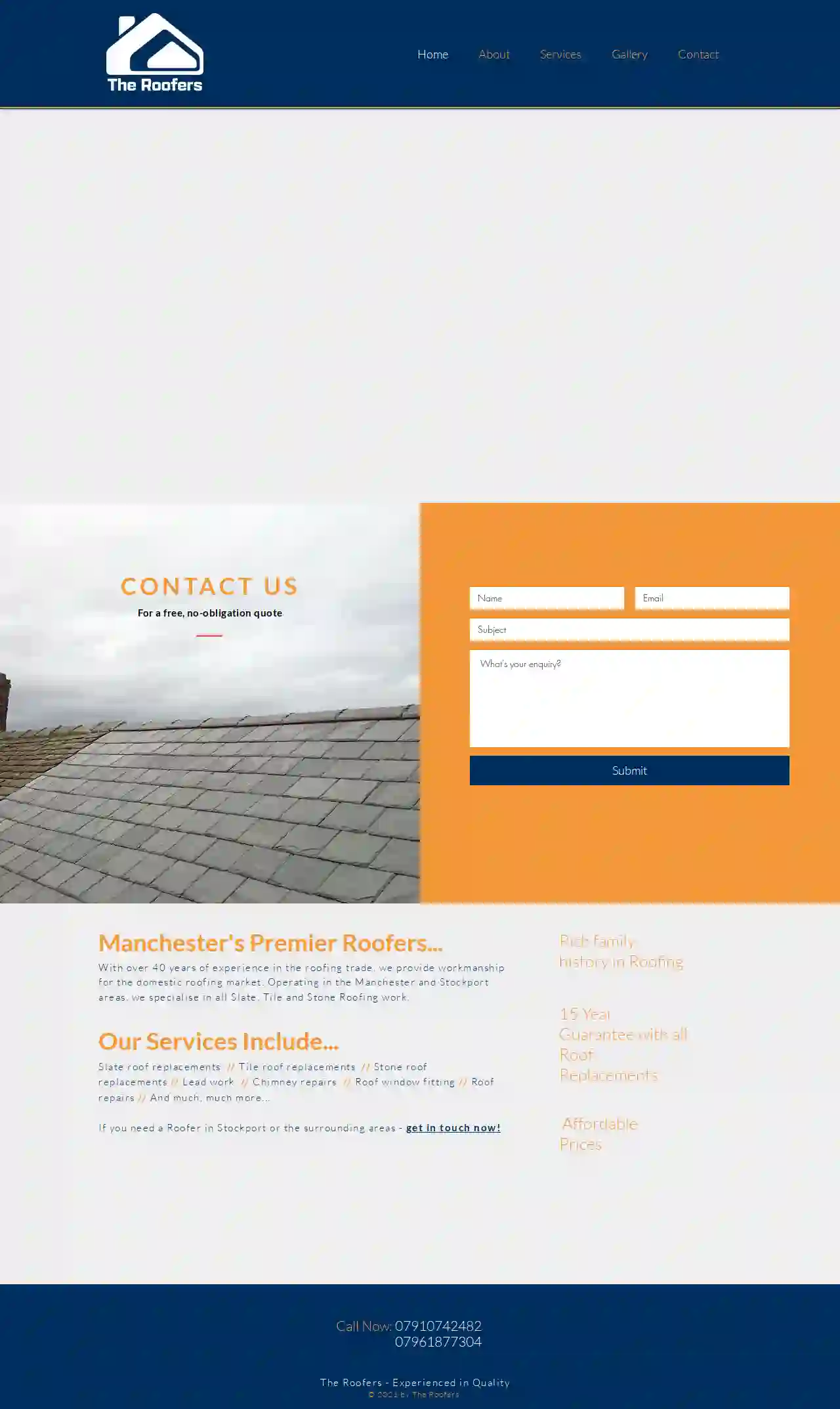
The Roofers
51 reviewsGBManchester's Premier Roofers... With over 40 years of experience in the roofing trade, we provide workmanship for the domestic roofing market. Operating in the Manchester and Stockport areas, we specialise in all Slate, Tile and Stone Roofing work. Our Services Include... Slate roof replacements, Tile roof replacements, Stone roof replacements, Lead work, Chimney repairs, Roof window fitting, Roof repairs, And much, much more... If you need a Roofer in Stockport or the surrounding areas - get in touch now! Rich family history in Roofing, 15 Year Guarantee with all Roof Replacements, Affordable Prices, Call Now: 07910742482. The Roofers - Experienced in Quality. Copyright 2021 by The Roofers.
- Services
- Why Us?
- Gallery
Get Quote
Prime Roofing Manchester Ltd
Manchester Business Park, Didsbury, Unit 10, 11 & 12, Manchester, M21 9AA, GBPrime Roofing Manchester is a family-run business with over 20 years of experience in the roofing industry. We pride ourselves on providing high-quality workmanship and excellent customer service. We offer a wide range of roofing services, including new roof installations, roof repairs, and roof maintenance. We are fully insured and accredited, and we are committed to providing our customers with the best possible service. Our team of experienced roofers is dedicated to providing our customers with the highest quality workmanship. We use only the best materials and equipment, and we are always up-to-date on the latest roofing techniques. We are committed to providing our customers with a stress-free roofing experience. We offer a free no obligation quote on all of our services. Contact us today to learn more about our services or to schedule a free consultation.
- Services
- Why Us?
Get Quote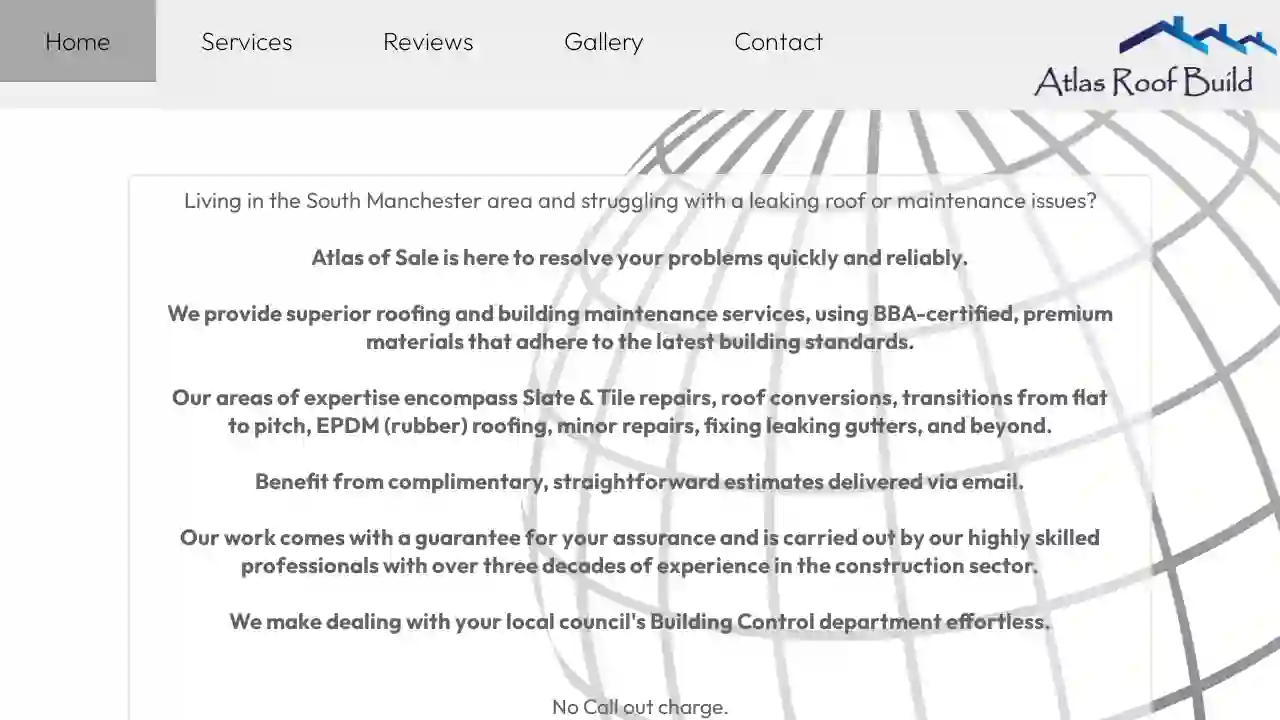
Atlas Roofing and Building Services
4.846 reviews46 Helsby Road, Sale, M33 2XD, GBLiving in South Manchester with a leaking roof or maintenance issues? Atlas of Sale is here to resolve your problems quickly and reliably. We provide superior roofing and building maintenance services, using BBA-certified, premium materials that adhere to the latest building standards. Our areas of expertise encompass Slate & Tile repairs, roof conversions, transitions from flat to pitch, EPDM (rubber) roofing, minor repairs, fixing leaking gutters, and beyond. Benefit from complimentary, straightforward estimates delivered via email. Our work comes with a guarantee for your assurance and is carried out by our highly skilled professionals with over three decades of experience in the construction sector. We make dealing with your local council's Building Control department effortless. No Call out charge. Domestic roofing contractors. Insurance claims welcome. Insured & fully bonded Discover our 5 Star Reviews on Special discounted rates are available for our senior citizens. Ask a Question Roofer Near Me: Altrincham, Bowden, Cheadle, Chorlton, Didsbury, Eccles, Flixton, Gatley, Hale, Heald Green, Lymm, Northenden, Old Trafford, Partington, Sale, Stretford, Timperley, Trafford, Urmston, West Didsbury, Whalley Range, Wilmslow, Withington, Wythenshawe
- Services
- Why Us?
- Accreditations
- Our Team
- Testimonials
- Gallery
Get Quote
Over 12,314+ Roofing Contractors on our platform
Our roofing pros operate in Manchester and surrounding areas!
Roofyng.co.uk has curated and vetted Top Roofing Companies in and around Manchester. Find a trustworthy pro today.
Shingle Roofing FAQs
- Class A: The highest fire rating, indicating excellent resistance to external fire exposure. Most asphalt shingles are Class A rated.
- Class B: Offers moderate fire resistance.
- Class C: Provides minimal fire resistance.
- Architectural shingles (dimensional shingles): Have a thicker, multi-layered construction, giving them a more dimensional and aesthetically appealing look. They also offer increased durability, wind resistance, and often come with longer warranties.
- Three-tab shingles: Feature a single layer of asphalt and have a flat appearance with three tabs per strip. They are typically more affordable but have a shorter lifespan and lower wind resistance than architectural shingles.
- Roof condition: Your shingle roof should be in good condition and have a sufficient lifespan remaining to support the solar panels.
- Structural integrity: The roof structure must be strong enough to handle the additional weight of the solar panels.
- Orientation and shading: The roof's orientation and any shading from trees or other structures will affect the efficiency of the solar panels.
- Professional installation: It's essential to have both a qualified roofing contractor and a reputable solar panel installer work together to ensure the solar panels are installed correctly without damaging the roof.
What are the fire ratings for shingles?
How do I repair a leak in my shingle roof?
What is the difference between architectural shingles and three-tab shingles?
Can I install solar panels on a shingle roof?
What are the fire ratings for shingles?
- Class A: The highest fire rating, indicating excellent resistance to external fire exposure. Most asphalt shingles are Class A rated.
- Class B: Offers moderate fire resistance.
- Class C: Provides minimal fire resistance.
How do I repair a leak in my shingle roof?
What is the difference between architectural shingles and three-tab shingles?
- Architectural shingles (dimensional shingles): Have a thicker, multi-layered construction, giving them a more dimensional and aesthetically appealing look. They also offer increased durability, wind resistance, and often come with longer warranties.
- Three-tab shingles: Feature a single layer of asphalt and have a flat appearance with three tabs per strip. They are typically more affordable but have a shorter lifespan and lower wind resistance than architectural shingles.
Can I install solar panels on a shingle roof?
- Roof condition: Your shingle roof should be in good condition and have a sufficient lifespan remaining to support the solar panels.
- Structural integrity: The roof structure must be strong enough to handle the additional weight of the solar panels.
- Orientation and shading: The roof's orientation and any shading from trees or other structures will affect the efficiency of the solar panels.
- Professional installation: It's essential to have both a qualified roofing contractor and a reputable solar panel installer work together to ensure the solar panels are installed correctly without damaging the roof.